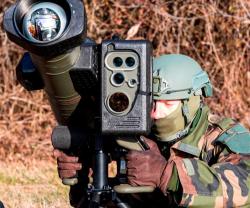During last week’s Eurosatory Exhibition in Paris (13-17 June), the Italian Minister of Defense, Roberta Pinotti, and the French Minister of Defense, Jean-Yves Le Drian, signed a ‘Cooperation Arrangement’ agreement which aims to pursue the joint development of the Aster 30 Block 1 NT missile. With this agreement, Italy is joining with France who launched the development program in December 2015.
The Aster 30 Block 1 NT program comprises, in addition to the upgrade of the Aster missile, the modernization of the SAMP/T systems currently in service with the French Air Force and the Italian Army. These systems as a result will see themselves featuring enhanced capabilities notably against ballistic missiles and thereby making essential contributions to the NATO program in this domain.
Antoine Bouvier, CEO of MBDA, declared: “Today marks a very important date for European defense cooperation and for MBDA in particular. The Aster missile program is Europe’s most ambitious tactical missile program. The two countries, which have carried out this program for many years, have just laid out a robust route map that will see the Aster program well into the next decade, which will help to sustain industrial know how for many years to come and which is key to ensuring French and Italian sovereignty.”
“Aster is in fact much more than a missile. It is a whole family of air defense and anti-missile systems which has been adopted by 11 armed forces around the world. Aster represents the leading edge of worldwide military capability and as such serves to consolidate the European missile industry,” he added.
Launched in 1988 by France and Italy, the Aster family (known also as FSAF – Future Surface-to-Air Family) exists as a ground based air and anti-missile defense system in service with the Italian Army and the French Air Force. It is also deployed in its naval version for the self-defense of the French and Italian Navies aircraft carriers and provides the self, local and fleet area defense capability on British, French and Italian frigates and destroyers.
The Aster 30 Block 1 NT program, which has just been agreed by France and Italy, comprises an evolution in the electronics of the Aster 30 Block 1 missile as well as an adaptation of the SAMP/T ground based systems to take into account the new missile which will be available as of 2023. The UK, which deploys Aster missiles on its Type 45 destroyers, declared during the Franco-British summit held in Amiens in March 2016, that it is considering the Aster Block 1 NT for its destroyers.
Aster systems play an active role in NATO’s ALTBMD (Active Layered Theatre Ballistic Missile Defence) in defending allied forces against ballistic threats and, as such, represent a major Franco-Italian contribution to this program.
To date, 1,600 Aster missiles have been ordered by 11 armed forces customers around the world and Aster-based systems are demonstrating daily their interoperability with the air defense networks of these forces and with those of NATO. The Aster systems of Italy’s Orrizonte frigates took part in establishing the no fly zone over Libya which was put in place by the UN in 2011. The Italian Army’s SAMP/T systems are currently being deployed in Turkey in the NATO Support to Turkey initiative to protect the country from the potential ballistic missile threat emanating from Syria.
With a significant presence in five European countries and within the USA, in 2015 MBDA achieved a turnover of € 2.9 billion with an order book of € 15.1 billion. With more than 90 armed forces customers in the world, MBDA is a world leader in missiles and missile systems.
MBDA is the only European group capable of designing and producing missiles and missile systems that correspond to the full range of current and future operational needs of the three armed forces (land, sea and air). In total, the group offers a range of 45 missile systems and countermeasures products already in operational service and more than 15 others currently in development.
MBDA is owned jointly by Airbus Group (37.5%), BAE Systems (37.5%), and Leonardo-Finmeccanica (25%).






















